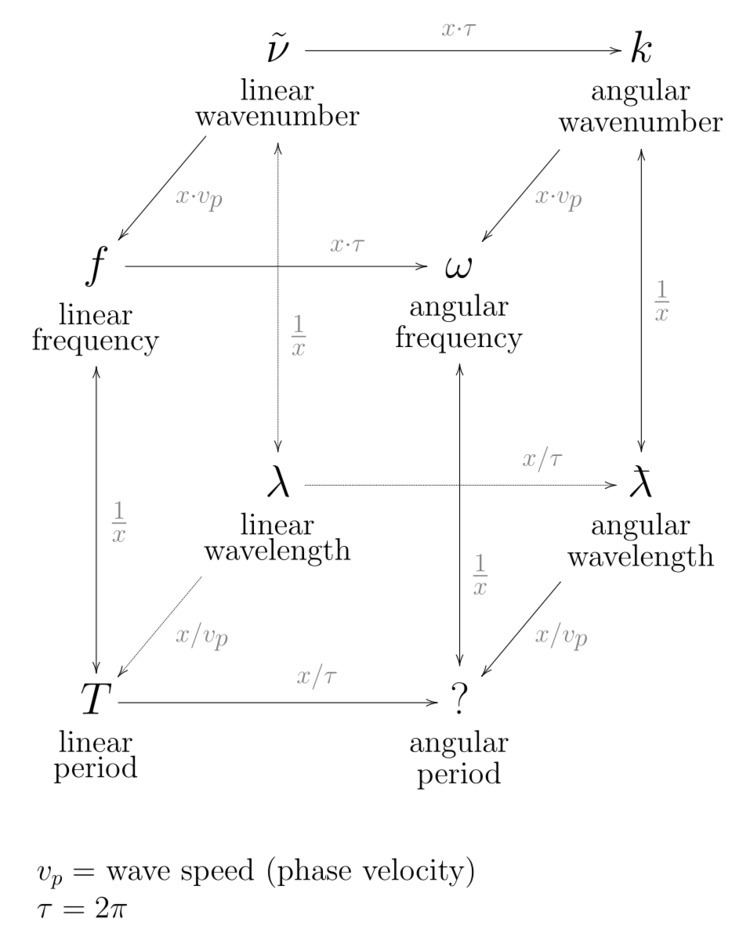 | ||
In the physical sciences, the wavenumber (also wave number) is the spatial frequency of a wave, either in cycles per unit distance or radians per unit distance. It can be envisaged as the number of waves that exist over a specified distance (analogous to frequency being the number of cycles or radians per unit time).
Contents
In multidimensional systems, the wavenumber is the magnitude of the wave vector. The space of wave vectors is called reciprocal space. Wave numbers and wave vectors play an essential role in optics and the physics of wave scattering, such as X-ray diffraction, neutron diffraction, and elementary particle physics.
For quantum mechanical waves, wavenumber multiplied by Planck's constant is the canonical momentum.
Wavenumber can be used to specify quantities other than spatial frequency. In optical spectroscopy, it is often used as a unit of temporal frequency assuming a certain speed of light. In this context, it is the number of cycles—not radians—per unit length, usually one centimeter. In the same domain, wavenumber can also be used as a unit of energy; 1 cm−1 of energy is the amount of energy in a single photon with a wavelength of 1 cm, the conversion being done using Planck's relation. For example, 1 cm−1 implies 1.23984×10−4 eV, and 8065.54 cm−1 implies 1 eV.
Definition
It can be defined as either:
There are four total symbols for wavenumber. Under the first definition ν,
When wavenumber is represented by the symbol ν, a frequency is still being represented, albeit indirectly. As described in the spectroscopy section, this is done through the relationship
It has dimensions of reciprocal length, so its SI unit is the reciprocal of meters (m−1). In spectroscopy it is usual to give wavenumbers in cgs unit, i.e., reciprocal centimeters (cm−1); in this context the wavenumber was formerly called the Kayser, after Heinrich Kayser (some older scientific papers used this unit, abbreviated as K, where 1 K = 1 cm−1). The angular wavenumber may be expressed in radians per meter (rad·m−1), or as above, since the radian is dimensionless.
For electromagnetic radiation in vacuum, wavenumber is proportional to frequency and to photon energy. Because of this, wavenumbers are used as a unit of energy in spectroscopy.
Complex
A complex-valued wavenumber can be defined for a medium with complex-valued permittivity ε, permeability μ0 and refraction index n as:
where k0 is the free-space wavenumber, as above. The imaginary part of the wavenumber expresses attenuation per unit distance and is useful in the study of exponentially decaying evanescent fields.
In wave equations
Here we assume that the wave is regular in the sense that the different quantities describing the wave such as the wavelength, frequency and thus the wavenumber are constants. See wavepacket for discussion of the case when these quantities are not constant.
In general, the angular wavenumber
where
For the special case of an electromagnetic wave in vacuum, where vp = c, k is given by
where E is the energy of the wave, ħ is the reduced Planck constant, and c is the speed of light in a vacuum.
For the special case of a matter wave, for example an electron wave, in the non-relativistic approximation (in the case of a free particle, that is, the particle has no potential energy):
Here p is the momentum of the particle, m is the mass of the particle, E is the kinetic energy of the particle, and ħ is the reduced Planck's constant.
Wavenumber is also used to define the group velocity.
In spectroscopy
In spectroscopy, "wavenumber"
The historical reason for using this spectroscopic wavenumber rather than frequency is that it proved to be convenient in the measurement of atomic spectra: the spectroscopic wavenumber is the reciprocal of the wavelength of light in vacuum:
which remains essentially the same in air, and so the spectroscopic wavenumber is directly related to the angles of light scattered from diffraction gratings and the distance between fringes in interferometers, when those instruments are operated in air or vacuum. Such wavenumbers were first used in the calculations of Johannes Rydberg in the 1880s. The Rydberg–Ritz combination principle of 1908 was also formulated in terms of wavenumbers. A few years later spectral lines could be understood in quantum theory as differences between energy levels, energy being proportional to wavenumber, or frequency. However, spectroscopic data kept being tabulated in terms of spectroscopic wavenumber rather than frequency or energy.
For example, the spectroscopic wavenumbers of the emission spectrum of atomic hydrogen are given by the Rydberg formula:
where R is the Rydberg constant, and ni and nf are the principal quantum numbers of the initial and final levels respectively (ni is greater than nf for emission).
A spectroscopic wavenumber can be converted into energy per photon E by Planck's relation:
It can also be converted into wavelength of light:
where n is the refractive index of the medium. Note that the wavelength of light changes as it passes through different media, however, the spectroscopic wavenumber (i.e., frequency) remains constant.
Conventionally, inverse centimeter (cm−1) units are used for
